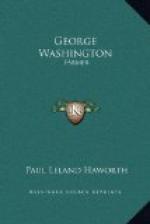In 1793 he built a new sixteen-sided barn on the
[ILLUSTRATION: Part of Washington’s Plan for His Sixteen-Sided Barn]
Dogue Run Farm. The plan of this barn, drawn by Washington himself, is still preserved and is reproduced herewith. He calculated that one hundred and forty thousand bricks would be required for it and these were made and burnt upon the estate. The barn was particularly notable for a threshing floor thirty feet square, with interstices one and a half inches wide left between the floor boards so that the grain when trodden out by horses or beat out with flails would fall through to the floor below, leaving the straw above.
This floor was to furnish an illustration of what Washington called “the almost impossibility of putting the overseers of this country out of the track they have been accustomed to walk in. I have one of the most convenient barns in this or perhaps any other country, where thirty hands may with great ease be employed in threshing. Half the wheat of the farm was actually stowed in this barn in the straw by my order, for threshing; notwithstanding, when I came home about the middle of September, I found a treading yard not thirty feet from the barn-door, the wheat again brought out of the barn, and horses treading it out in an open exposure, liable to the vicissitudes of the weather.”
I think we may safely conclude that this was one of those rare occasions when George lost his temper and “went up in the air!”
Under any conditions treading or flailing out wheat was a slow and unsatisfactory process and, as Washington grew great quantities of this grain, he was alert for a better method. We know that he made inquiries of Arthur Young concerning a threshing machine invented by a certain Winlaw and pictured and described in volume six of the Annals, and in 1790 he watched the operation of Baron Poelnitz’s mill on the Winlaw model near New York City. This mill was operated by two men and was capable of threshing about two bushels of wheat per hour—pretty slow work as compared with that of a modern thresher. And the grain had to be winnowed, or passed through a fan afterward to separate it from the chaff.
Finally in 1797 he erected a machine on plans evolved by William Booker, who came to Mount Vernon and oversaw the construction. Next April he wrote to Booker that the machine “has by no means answered your expectations or mine,” At first it threshed not quite fifty bushels per day, then fell to less than twenty-five, and ultimately got out of order before five hundred bushels had been threshed, though it had used up two bands costing between eight and ten pounds. Booker replied that he had now greatly improved his invention and would come to Mount Vernon and make these additions, but whether or not he ever did so I have failed to discover.




